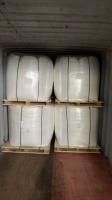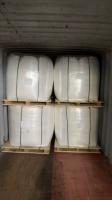Our Products
Polyacrylamide / The classification functions of mud chemicals from Chinafloc

Mud chemicals, commonly known as drilling fluid additives, are essential materials used to prepare and maintain drilling fluids for oil, gas, geothermal, and mining wells. Drilling mud is the lifeline of the drilling operation because it performs critical functions such as cooling the drill bit, removing cuttings, maintaining hydrostatic pressure, stabilizing the wellbore, and minimizing formation damage. To achieve these functions under widely varying geological and operational conditions, many different chemicals are formulated into the mud system. These chemicals can be classified into several major categories based on their primary functions, including viscosifiers, fluid-loss control agents, shale inhibitors, lubricants, weighting materials, deflocculants, pH control agents, emulsifiers, surfactants, and specialty polymers. Each category contributes uniquely to the mud’s performance, ensuring efficient, safe, and stable drilling.
1. Viscosifiers / Rheology Modifiers
Viscosifiers increase the carrying and suspension capacity of the drilling mud. Their primary function is to ensure that drilled cuttings are lifted from the wellbore and transported to the surface. They also suspend weight materials like barite when circulation stops.
Common viscosifiers include:
-
Bentonite clay
-
Xanthan gum (XC polymer)
-
PAC (polyanionic cellulose)
-
CMC (carboxymethyl cellulose)
-
Anionic polyacrylamide (APAM)
-
Starch and natural gums
Functions:
-
Builds viscosity in water-based mud
-
Enhances hole cleaning
-
Prevents settling of solids
-
Improves gel strength
-
Stabilizes the rheology in HPHT drilling
Viscosifiers are critical in high-angle wells where cuttings transport is difficult.
2. Fluid-Loss Control Agents
Fluid-loss additives minimize the escape of drilling fluid filtrate into underground formations. Excess filtrate invasion can cause wellbore instability, reservoir damage, stuck pipe, and formation swelling.
Common fluid-loss agents:
-
PAC (low and high viscosity)
-
Starch derivatives
-
Lignite and modified lignite
-
Asphaltic additives
-
Synthetic polymers such as polyacrylamide
Functions:
-
Form a thin, low-permeability filter cake on wellbore walls
-
Reduce shale hydration and swelling
-
Minimize water invasion into sensitive formations
-
Protect permeability of reservoirs
These additives are vital for drilling through shale and sandstone formations.
3. Weighting Materials
Weighting materials increase the density of drilling mud to control formation pressures, prevent blowouts, and maintain hydrostatic balance.
Common weighting agents:
-
Barite
-
Hematite
-
Calcium carbonate (fine, medium, and coarse grades)
Functions:
-
Increase mud density
-
Control formation pressure
-
Prevent kicks and blowouts
-
Enhance wellbore stability in deep wells
Weighting agents must be finely ground to minimize abrasion and avoid excessive solid buildup.
4. Shale Inhibitors / Clay Stabilizers
Shale formations often contain reactive clays that swell or disperse when exposed to water, leading to sloughing, wellbore collapse, and hole enlargement. Shale inhibitors stabilize these clays.
Common shale inhibitors include:
-
Potassium chloride (KCl)
-
Sodium chloride
-
Polyamines
-
Glycols
-
Silicate-based inhibitors
-
Anionic and cationic polymers
Functions:
-
Reduce clay swelling and hydration
-
Stabilize wellbore walls
-
Maintain cuttings integrity
-
Prevent bit balling
Shale inhibitors are essential in shale gas, coal seam, and clay-rich sedimentary basins.
5. Lubricants and Drag Reducers
Lubricants reduce friction between the drill string and wellbore. This improves the rate of penetration and reduces torque and drag, especially in horizontal wells.
Common lubricants:
-
Synthetic oils
-
Ester-based lubricants
-
Graphite
-
Glycol blends
-
Polymeric lubricants
Functions:
-
Reduce torque and drag
-
Minimize stuck pipe incidents
-
Protect drilling equipment from wear
-
Improve sliding efficiency in long laterals
Lubricants are particularly valuable in extended-reach drilling.
6. Deflocculants / Thinners
Deflocculants prevent excessive viscosity by dispersing clay particles and reducing flocculation. They help control rheology when solids concentration increases.
Common deflocculants:
-
Lignite
-
Tannins
-
Chrome-free lignosulfonates
-
Polyphosphates
-
Modified acrylic polymers
Functions:
-
Reduce plastic viscosity and gel strength
-
Prevent solid agglomeration
-
Improve mud flow properties
-
Reduce dilution requirements
These chemicals are essential when drilling through formations that generate high amounts of fines.
7. pH Control Agents and Alkalinity Builders
Maintaining the proper pH ensures mud stability, effective polymer hydration, and corrosion control.
Common chemicals:
-
Caustic soda (NaOH)
-
Potassium hydroxide
-
Lime (CaO)
-
Soda ash (Na₂CO₃)
Functions:
-
Maintain desired alkalinity
-
Prevent corrosion
-
Improve polymer performance
-
Remove hardness ions
Balanced pH improves fluid quality and stability.
8. Emulsifiers and Surfactants
Oil-based mud (OBM) and synthetic-based mud (SBM) require emulsifiers to form stable emulsions. In water-based mud (WBM), surfactants improve wetting and dispersion.
Common emulsifiers and surfactants:
-
Fatty acids
-
Amines
-
Polyamide emulsifiers
-
Nonionic surfactants
Functions:
-
Stabilize oil-in-water or water-in-oil emulsions
-
Improve mud lubricity
-
Enhance penetration rate
-
Reduce surface tension
These chemicals are the backbone of OBM and SBM systems.
9. Loss-Circulation Materials (LCM)
When drilling encounters natural fractures or vuggy formations, the mud may be lost. LCM additives plug these openings.
Common LCMs:
-
Calcium carbonate coarse grades
-
Graphite
-
Mica
-
Fibrous materials
-
Ground nut shells
-
Cellulose fibers
Functions:
-
Seal fractures and voids
-
Prevent loss circulation
-
Maintain mud volume and hydrostatic head
-
Avoid formation damage
10. Specialty Polymers
Many modern mud systems rely on advanced polymers.
Examples:
-
Polyacrylamides
-
Polyamines
-
Polydadmac
-
Biopolymers
Functions:
-
Enhance viscosity
-
Control fluid loss
-
Stabilize wellbore
-
Improve solids separation
Advanced polymers are essential for environmentally friendly and high-performance drilling fluids.
Conclusion
Mud chemicals are vital for successful drilling operations. Their classification—viscosifiers, fluid-loss agents, weighting materials, shale inhibitors, lubricants, deflocculants, pH controllers, emulsifiers, LCM, and specialty polymers—reflects the diverse and highly specialized functions required to maintain drilling efficiency, safety, and wellbore stability. By combining these additives strategically, engineers can design drilling fluids that perform reliably under a wide variety of geological and operational conditions.



620_small.jpg)

